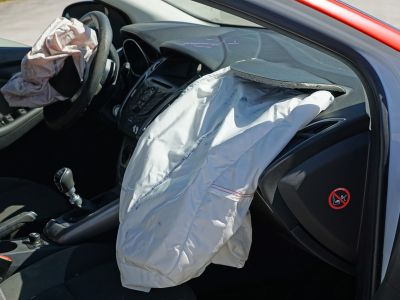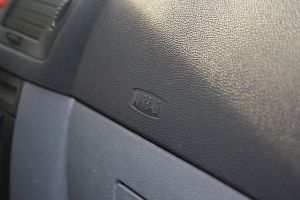Air Bags, Safety, and Social Experiments

In the last two decades of the twentieth century, engineers in the automotive industry who developed and tested air bags acted upon their social responsibilities by engaging in the development of the technology, the evolution of safety policy, and public education to improve air bags and the outcomes of adding them to cars. A part of the Research, Ethics, and Society project, this case can be used to address the social responsibilities of researchers, particularly those concerning ongoing engagement with issues of public safety.
- How can engineers continue to assess product safety once products are on the market? Should they be involved in these kinds of activities? Why or why not?
In the late 1980s and early 1990s, government regulations, marketing, and public demand resulted in the installation of air bags in many new cars to decrease injuries and fatalities in automobile accidents. Air bags, however, added a new complexity to what happens in car crashes—including an additional explosion—and automotive engineers were not completely sure how air bags would behave in real-world situations. Engineers who developed and tested air bags acted upon their social responsibility by engaging in the development of the technology, the evolution of safety policy, and public education to improve air bags and the outcomes of adding them to cars.
Early Air Bags
An air bag in the laboratory works differently than in real life. Laboratory testing of air bags cannot possibly include all types of collision conditions, nor does most testing involve real vehicle occupants. Testing air bags in controlled conditions leads to uncertainties about how air bags will behave in unpredictable future circumstances:
- Every crash is different. Designing an inflatable bag to inflate only when needed is difficult.
- Inflation rates need to be not too slow and not too fast. Both situations can result in fatalities.
- Real, live automobile occupants are not like test crash dummies.
Engineers faced questions like: Would drivers use seat belts in addition to air bags? If so, what kind of seat belt? How close would the driver or passenger be to the air bag when it inflated? What would happen if more than two people were in a front passenger seat?
Initial Monitoring of Air Bags for Public Safety
Recognizing that they did not know exactly how air bags would behave on the road, engineers working for automobile manufacturers and parts suppliers collaborated with insurance companies and government officials (many of whom were also trained in engineering) to carefully monitor the results of real crashes. Even after twenty years of development, they found that the air bags being produced in the late 1980s had several shortcomings. Air bag engineers quickly responded with several technical improvements. They
- Moved air bag vents so that escaping hot nitrogen gas would not burn the hands of the driver
- Reduced abrasions by placing a tether inside the air bag to keep the bag from over bulging into the driver or passenger
Engineers urged people to wear their seatbelts to ensure maximum protection, and testified before state legislatures that all drivers needed to wear seatbelts and that people who sat very close to their steering wheels could be injured or killed by a rapidly inflating air bag.
Continued Monitoring
Unfortunately, these small changes did not solve all the problems. In the mid-1990s, the continued monitoring efforts revealed that the powerful deployment of air bags had killed a handful of drivers and passengers, all of whom had been traveling at low speeds when a collision occurred. Engineers believed that in many of these cases drivers were braking at the time of impact, and as their cars slowed, their bodies continued to move forward and were too close to the air bag when it deployed. Continued research showed that women and children were especially susceptible to air bag dangers.
This information put the engineers and regulators in a bind. They had evidence that air bags could save thousands of lives a year, but wanted to eliminate unnecessary deaths. Engineers in the auto industry (both as individuals and through automobile lobbying organizations), therefore, worked with insurance companies, the National Safety Council, and government regulators, to develop recommendations for technical changes to air bags and educate the public on how to use air bags safely by changing their driving style.
How did industry engineers respond politically?
- Gathered and analyzed data in the field and shared this data with the National Highway Traffic Safety Administration (NHTSA)
- Testified before Congress about the effectiveness of air bags in reducing car crash fatalities and injuries when accompanied by seat belt use
How did industry engineers work with private industry?
- Inspected car crashes with representatives from insurance companies and automakers
- Petitioned the government, through the Motor Vehicle Manufacturer’s Association, to mandate a warning label that would tell parents to put child safety seats in the back seats of vehicles rather than in the front seat
How did industry engineers work with the public?
- Gave media interviews to inform the public about the potential dangers of air bags
- Contributed to public education materials, including the recommendation that there be at least ten inches of space between a driver and the steering wheel; placing infants and toddlers in child safety seats; and putting infants and their child seats in the back seat of vehicles
By the year 2000, the number of deaths resulting from air bags had dropped significantly, due in part to air bag redesign and education efforts of engineering professionals.
This case is based upon work supported by the National Science Foundation under Grant No. 1033111. Any opinions, findings, and conclusions or recommendations expressed in this material are those of the author(s) and do not necessarily reflect the views of the National Science Foundation.
Our project team and advisory board read many drafts and provided important insights. Project team: Heather Canary, Joseph Herkert, Jameson Wetmore, Ira Bennett, and Jason Borenstein. Advisory board: Joan Brett, Jim Svara, Richard Fish, Juergen Gadau, Shelli McAlpine, Timothy Newman, Byron Newberry, Patrick Phelan, and Petra Schroeder.


